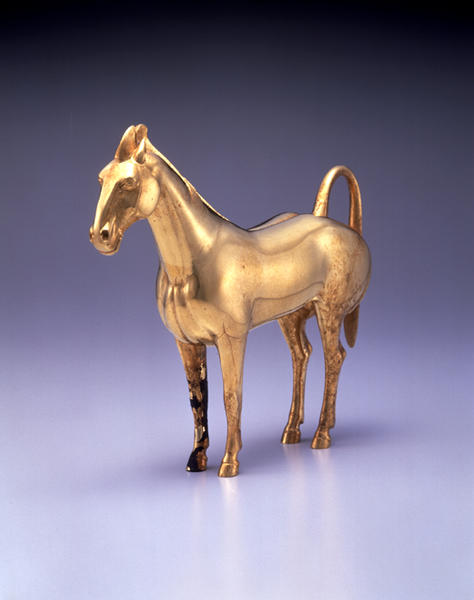Small Figure of Horse
- China
- China, Western Han period
- 2nd century B.C.
- Gold
- H-25.4 D-6.3 W-30.9
Catalogue Entry(2004)
Horse
Gold
Western Han dynasty
H. 25.4cm, W. 30.9cm, Depth 6.3cm
Miho Museum
The long limber form of this horse is shown realistically. The staunchly extended legs, thick chest, muscular haunches all convey the horse’s power. The long neck, extended forward, and forelock, swept back, all reveal a horse form from the west, unlike the horse figurines found at emperor Shi Huangdi’s tomb. This same kind of realistic horse expression can be found in a gilt bronze horse (height 62 cm, length 76 cm) discovered in May 1981 in one of the subsidiary trenches in the vicinity of Wumingzhong, the largest domain among all the subsidiary tombs of the Maoling tomb. The majority of the bronzes excavated from this Wumingzhong site were inscribed Oyangxinjia,O and thus it is thought that this was the tomb of Princess Yangxinchang, sister of emperor Wu, who died around Yuanfeng 1 (110 BC) after her remarriage to Weiqing.
Emperor Wudi, buried at Maoling, sent ambassadors to Ferghana (Dayuan) in search of good horses. He was impressed by the horses that he received in Taichu 4 (101 BC) from that search, were superior to Wusun horses. This led the emperor to give the Otianma,O or celestial horse, designation to the Ferghana horses, switching it from the previous designation of Wusun horses by that name. He renamed the Wusun horses, Oxijima.O
However, close examination of this horse reveals that it has a ram-head with flaring nostrils, long torso, raised haunches with descending back line, and high tail placement. These characteristics can also be seen on the horses at cat. No. 2 and cat. No. 9. This gold horse weighs approximately 7 kilograms, which is approximately 30 yin, or about a single unit of the jun measure used during that period. We can thus consider that there might be some connection between this gold horse, and the gold horse and the 1,000 gold pieces sent with the emperor’s emissary to use in exchange for the horses before his military campaign in Ferghana. If we were to consider that this gold horse, and those seen at cat. Nos. 2 and 9 are representative of the characteristics of the Wusun horses who were in China before the Ferghana horses, this connection might be considered all the stronger.
These characteristics, the long neck, high forelock, long torso, etc., also reflect the features of the Akhal-Take horse which is famous in the Turkmenistan region today, or the western region of ancient Ferghana. This horse’s features are similar to those of the Ferghana horses.
